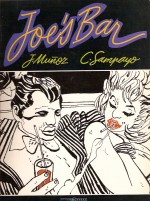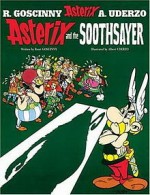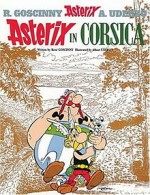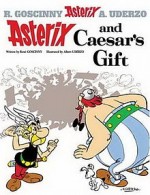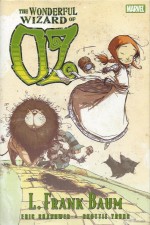
By L. Frank Baum, adapted by Eric Shanower & Skottie Young (Marvel)
ISBN: 978-0-7851-2921-9 (hb)Â Â Â Â Â Â Â Â Â 978-0-7851-2922-7 (tpb)
We all know the story of The Wizard of Oz – or at least the bare bones of it harvested to make the admittedly stunning 1939 film – but the truth is there’s a vast amount from that legendary 1900 novel by jobbing journalist and prolific author Lyman Frank Baum that remained unfilmed, and this superb and faithful adaptation by rabid fan Eric Shanower and artist Skottie Young rectifies and redresses those glaring tinseltown omissions and alterations with stunning skill and mesmerising charm.
As superb an illustrator as author, Shanower himself produced five original graphic novels set in Baum’s magic kingdom (The Enchanted Apples of Oz, The Secret Island of Oz, The Ice King of Oz, The Forgotten Forest of Oz, and The Blue Witch of Oz between 1986 and 1992, recently compiled into one scintillating chronicle as Adventures in Oz) as well as a new prose work, short stories and contributions to various academic and critical volumes on Baum and his creations.
In 2009 Marvel began producing a sequence of miniseries by Shanower and Skottie Young faithfully adapting Baum’s original texts, and the first 8-part classic has been collected as both a premier hardcover and trade paperback edition that will delight and astound both veteran and completely fresh readers.
Much of the familiar skeleton is there. Dorothy and her little dog Toto are spirited away from dreary, flat Kansas by a cataclysmic cyclone in the family house which, after many hours in the air, dumps the pair in a fantastic land of rolling hills and glorious vistas.
Under the fallen domicile is a dead witch and the blue-clad Munchkins who populate the place couldn’t be happier.
When the Good Witch of the North appeared, she explains that Dorothy has done a great thing, but she cannot help the little girl return home to her Uncle Henry and Aunt Em. Nobody has ever heard of Kansas, but perhaps the great and terrible Wizard of Oz could help. Dorothy and Toto are advised to follow the Yellow Brick Road to his City of Emeralds in the centre of Oz, and since the girl’s cheap boots were hardly up to the journey, it’s pretty lucky she was awarded the Silver Shoes of the deceased Hag…
She walked for a long time, feted everywhere by happy, witch-free folks and eventually encountered a scarecrow in a field of corn. He wasn’t much different from the ones at home except that he winked at her and struck up a conversation…
The straw man was uncomfortable and Dorothy extricated him from his uncomfortable position stranded on high with a pole up his back, after which they discussed her plight and the Wizard’s ability to do anything. After relating how he was made the Scarecrow, hoping the green sage could provide him with brains, asked the little lass if he could accompany her to the City of Emeralds…
Their route took them through a darkly wooded area overgrown with trees and as night was falling, Dorothy wanted to stop. The Scarecrow saw a cottage deep in the trees and although it was scary and abandoned they planned to rest there. However, whilst looking for water they heard eerie screams and followed them to a tin woodman immobile and rusting…
Once the little girl had used a handy oilcan to liberate him the Woodsman related a tragic – and gruesome – tale of cursed love and an enchanted axe which that turned an enamoured young man, piece by piece, into an unfeeling kettle without a heart.
Perhaps the Wizard could provide one if he joined them on their quest…?
As they journeyed onwards together through the seemingly endless forest Dorothy’s provisions began to run out and they were attacked by a fearsome and magnificent lion. As Toto bravely defended his mistress, the King of Beasts made to devour the dog and angry Dorothy slapped the savage beast’s face.
The predator crumbled into tears and shared his own tale of woe: a life built on bluff and the permanent terror that all the forest creatures currently afraid of him might discover that the Lion was far more scared of them. He too joined the party for Oz…
As they proceeded on their way they encountered and conquered many perils together: huge gorges cutting across the road, savage sabre-toothed Kalidahs, a huge river and a field of toxic poppies.
It was here that the Lion, Toto and Dorothy fell into an unshakable sleep, but luckily the Tin Woodman saved the life of a Field-mouse who happened to be the Queen of the mice. and in gratitude she bade all her millions of subjects to carry the slumberers to safety after which she gave Dorothy a whistle that could summon aid from the mice should she ever again need it.
Eventually they reached pleasant countryside where all the houses were painted green and at long last saw the high green wall of the City of Emerald…
After much shilly-shallying each postulant was granted an audience with the Wizard, who looked alarmingly different to each one of them and said they could only achieve their heart’s desires if they performed one little task – killing the deadly Wicked Witch of the West…
With no other choice the questors set off for the Land of the Winkies, defeating talking wolves, savage crow armies and killer bees before succumbing to an attack by flying monkeys which dismembered the Scarecrow and the Woodman and saw the Lion and Dorothy dragged off as slaves.
The feisty child’s life was one of terrible drudgery until the Witch stole one of the magic silver shoes and Dorothy threw a bucket of scrub-water over her…
With the Witch dead, the jubilant and liberated Winkies rebuilt the Woodman and reassembled the Scarecrow so that the triumphant adventurers could begin an epic Pilgrimage back to Oz and their promised rewards.
But their trials and tribulations were far from over…
And that’s barely past the half-way point in this astoundingly captivating book which is incontrovertibly the very best adaptation yet of one of the world’s greatest tales.
Shanower’s adaptation provides a far darker, more naturalistically vivid and far edgier atmosphere – after all, this was a story originally written at a time when it was still okay to frighten children or make them feel sad, and the grim facts of harsh life weren’t covered up unnecessarily – whilst Skottie Young’s gloriously stylised and vibrant interpretation is a wonder to behold, capturing idyllic fields of pastoral wonder, strange peoples, fantastic magic, scary beasts and spectacular events with supreme aplomb, all perfectly enhanced by the sensitive colour palette of Jean-Francois Beaulieu and Jeff Eckleberry’s deft calligraphy.
Also included are Shanower’s impassioned introduction ‘Blame it on Toto’, Baum’s original dedication from 1900 accompanied by a superb illustration of Dorothy and Toto by Young, a complete cover gallery of the miniseries, including variants by Shanower himself and J. Scott Campbell, an overview of the novels, theatrical productions and films and a stunning sketchbook section featuring working drawings and designs for Dorothy, The Cowardly Lion, Scarecrow, Tin Woodman, The Good Witch of the North, Toto, Winged Monkeys, The Wizard of Oz and The Wicked Witch of the West. All capped off by a behind-the-scenes feature on how the covers and colour pages were processed and assembled
If you’ve seen the films and cartoons you only think you know Oz. Start reading these magnificently lush and luxurious comics adaptations and learn the truth – and while you’re at it, don’t forget to read Baums’s (unabridged) prose masterpieces too; you can even read them for free, courtesy of Project Gutenberg.
Win, the Wise and Powerful, has Spoken…
© 2008, 2009 Marvel Characters, Inc. All rights reserved.


